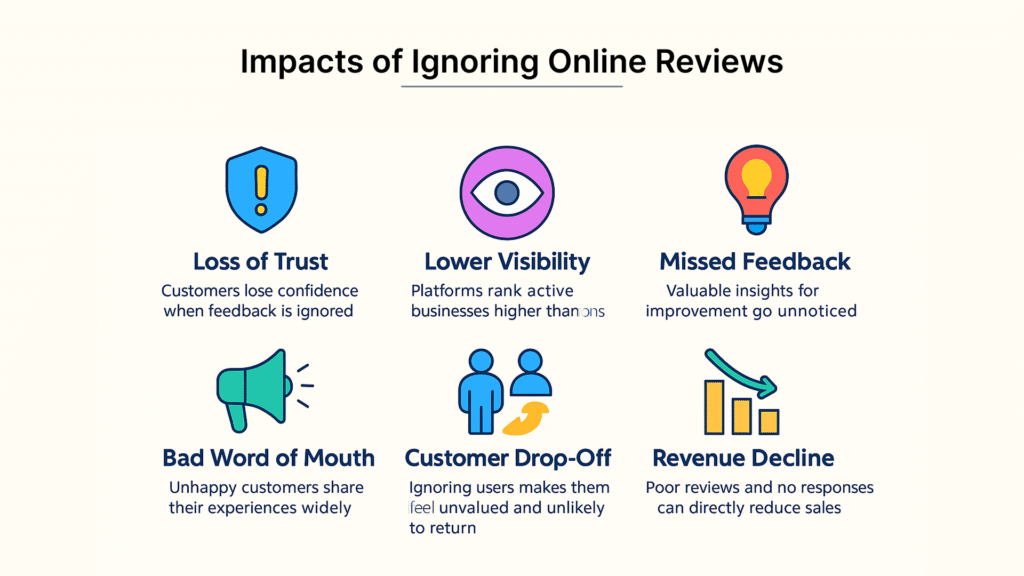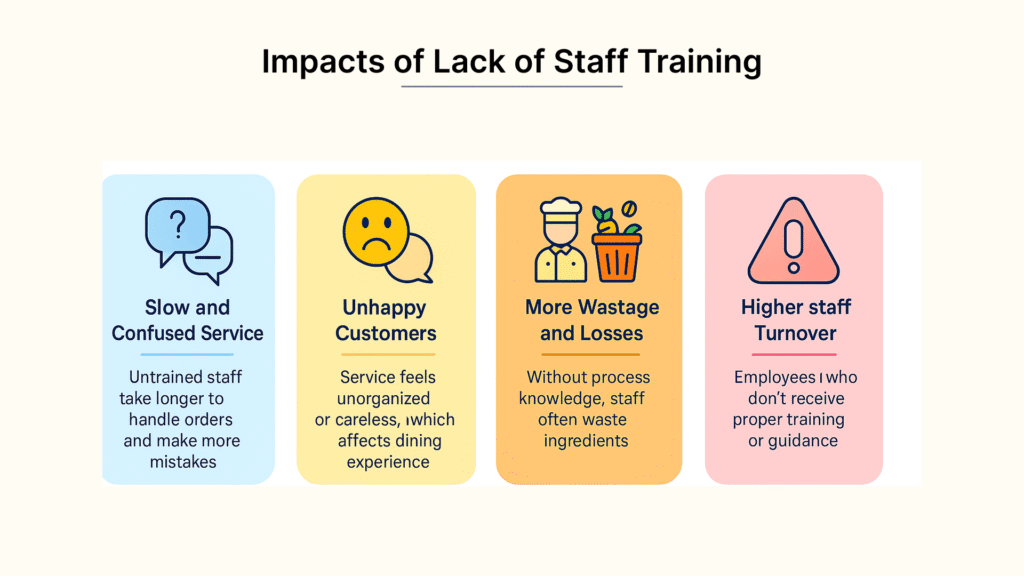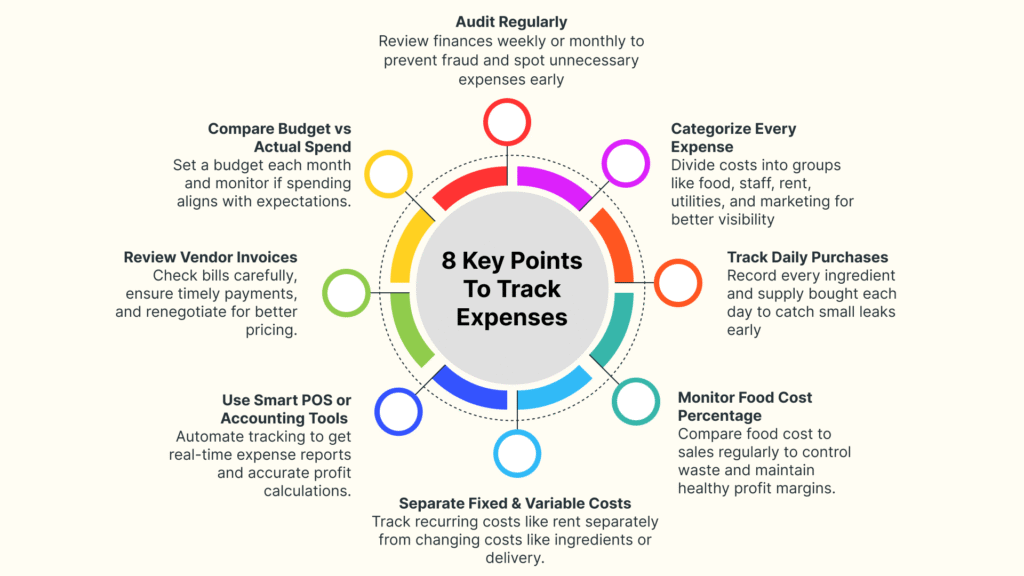Common restaurant mistakes can be the difference between thriving and merely surviving in this competitive industry. Despite the restaurant industry expected to surpass $1 trillion in sales this year for the first time in history, statistics show that nearly 30% of restaurants don’t survive their first year, and about 60% close within five years.
We’ve seen firsthand how these common restaurant problems and solutions often come down to the basics. From poor first impressions to inconsistent food quality, these common mistakes in restaurant service add up quickly. Unfortunately, many new restaurant owners make critical errors—diving into the business with passion for food but without understanding the market. What’s particularly concerning is that 73% of consumers will switch to a competitor after multiple bad experiences, while 70% of people who enter a restaurant don’t even know what they’re going to order ahead of time.
In this article, we’ll explore eight mistakes restaurants make daily and provide practical solutions to help you avoid them. Whether you’re a seasoned restaurateur or just starting out, addressing these issues could be the key to keeping your doors open long-term.
Poor Greetings at the Door
The moment a customer walks through your restaurant door sets the tone for their entire dining experience. First impressions form rapidly, yet many establishments fail to recognize the crucial importance of that initial greeting.

Common scenario with poor greetings
Walk into many restaurants and you’ll encounter hosts who barely look up from their station, offering impersonal greetings like “How many?” or “Do you want to sit in the dining room or bar?” These dismissive interactions immediately signal to guests that they’re an inconvenience rather than valued customers.
Other common poor greeting scenarios include:
- Staff appearing bored or busy when guests arrive
- Hosts asking solo diners “Just one?” (implying there’s something wrong with dining alone)
- Employees failing to acknowledge guests within the first few seconds
- Staff engaging with phones or computers instead of making eye contact
Research shows that without specific training and feedback systems, only 5-6% of customers receive proper greetings within 3 seconds of entering a restaurant. Furthermore, even when employees receive basic instructions on greeting procedures, many restaurants report that customer greetings remain inconsistent without proper management systems.
Why it’s a problem for first impressions?
A poor greeting isn’t just an awkward moment—it’s a significant business liability. According to research, 75% of customers are less likely to patronize a business where they feel disrespected. Additionally, 84% of consumers report that customer experience is equally important as the product or service itself.
First impressions in hospitality are especially critical because:
- 93% of a person’s overall judgment is determined by non-verbal communication
- 38% of first impressions are established by tone of voice alone
- A negative initial interaction can undermine trust in all subsequent service
In essence, that first greeting isn’t simply a pleasantry—it’s a fundamental element of your business model. Consequently, when hosts appear disinterested or unwelcoming, they effectively turn away potential loyal customers before they’ve even been seated.
Better approach to welcoming guests
Implementing effective greeting protocols requires both systems and training. Initially, focus on creating the right structural environment:
- Establish clear greeting expectations – Define exactly what constitutes an appropriate welcome (verbal acknowledgment within 3 seconds of entry)
- Create physical reminders – Door chimes or signals can significantly improve greeting consistency
- Implement feedback systems – Studies show that even with good systems, manager-delivered verbal and graphic feedback is necessary to achieve sustained high levels of customer greeting
For the actual greetings, train staff to:
- Stand up straight, smile, and make direct eye contact
- Use warm, personalized language: “Welcome to [restaurant name]! How many will be joining us today?” instead of “How many?”
- For solo diners, say “Will you be dining alone today?” rather than “Just one?”
- Maintain a calm, positive attitude regardless of how busy the restaurant is
- Listen attentively to guests before jumping to solutions
Remember that your hosts represent the restaurant’s overall attitude toward service. Proper training in these crucial first interactions isn’t just good manners—it’s essential business practice that directly impacts your bottom line.
Inconsistent Food Quality
Inconsistent food quality represents one of the most critical yet overlooked challenges in the restaurant industry. I’ve seen numerous establishments fall victim to this common restaurant mistake, often without realizing how dramatically it affects their bottom line.

What inconsistent food quality means?
Food inconsistency occurs when the same dish tastes or looks different across multiple visits. This inconsistency manifests through variations in flavor, texture, temperature, portion size, or presentation. Consider ordering your favorite risotto—one day it’s creamy and perfectly seasoned, the next it’s stiff and bland. Such unpredictability erodes customer trust, which is fundamental to restaurant success.
More than 60% of diners avoid returning to a restaurant after just one poor experience. Moreover, customers rarely come back because a dish could be good—they return because they know it will be good. Food consistency builds reliability, and reliability drives repeat business.
The consequences extend beyond just disappointed customers:
- Food waste through remakes and refunds
- Staff frustration and lower morale
- Negative online reviews affecting reputation
- Reduced table turnover due to preparation delays
Why food quality varies?
Inconsistent food quality typically stems from several root causes:
- Ingredient variability: Seasonal changes, supply chain issues, or fluctuating ingredient quality directly impact the final product. For instance, tomatoes in summer taste markedly different from winter tomatoes.
- Inadequate training and supervision: When kitchen staff lack proper training or oversight, variations in cooking techniques inevitably occur. This becomes particularly problematic during staff turnover when recipes are passed along verbally rather than documented.
- Poor equipment maintenance: Uneven cooking temperatures, malfunctioning appliances, or worn-out utensils significantly affect food preparation. Without regular calibration, even identical recipes produce different results.
- Lack of standardized recipes: Many restaurants still rely on memory or intuition rather than precise measurements. When recipes are unclear, portion control becomes impossible—leading to dishes that vary dramatically between shifts or locations.
- Poor inventory management: Improper storage conditions or expired ingredients compromise food quality before preparation even begins.
How to maintain consistent food quality?
Implementing systematic approaches to food consistency creates predictable excellence:
1. Standardize recipes and processesDevelop detailed digital recipe cards that include exact measurements, cooking times, temperatures, and plating instructions. These should be accessible to all kitchen staff via tablets or displays. For multi-element dishes, specify the preparation sequence for each component to maintain proper textures.
2. Invest in staff trainingRegular training sessions ensure all kitchen staff understand and follow standardized procedures. Training should cover cooking techniques, ingredient handling, and quality standards. Subsequently, implement supervision systems to verify adherence to these standards.
3. Implement quality control systemsConduct taste checks before each service period. Furthermore, establish feedback mechanisms that track customer comments, remakes, and returns to identify patterns in quality issues. Many successful restaurants use performance dashboards to compare metrics across shifts and locations.
4. Establish vendor relationshipsCreate clear quality benchmarks for suppliers and track their performance. Hence, if ingredient quality varies, you can quickly address the issue or find alternatives. Building strong relationships with reliable food suppliers ensures consistent ingredient quality.
5. Leverage technologyUse kitchen display systems that break down complex recipes into step-by-step instructions. In addition, implement inventory management tools that monitor ingredient freshness and storage conditions. These technologies reduce human error and maintain consistency even during peak service times.
By addressing these fundamental issues, restaurants can transform inconsistent food quality from a liability into a competitive advantage.
Ignoring Online Reviews
Online reputation can make or break your restaurant in today’s digital world. In fact, **[92% of food consumers read reviews](https://www.spindl.app/blog/effective-reviews-management-for-restaurants) before choosing where to eat**, demonstrating the immense power these digital opinions hold over your business success.

“Your customers are judging every aspect of every transaction and rating everything, from the friendliness of people, to the ease of doing business, to the quality of product, to service after the sale.” — Jeffrey Gitomer, Sales trainer, author of ‘The Little Red Book of Selling’
What ignoring online reviews looks like?
Restaurants that ignore online feedback typically display several concerning behaviors. They leave customer comments unanswered across platforms like Google, Yelp, and social media. According to research, 59% of operators still rely on third-party review sites, yet many fail to respond to feedback posted there. Even more concerning, 53% of customers expect businesses to respond to negative reviews within a week, but 63% say they’ve never heard back after leaving a negative review.
This silence extends beyond just ignoring complaints—it means missing opportunities to acknowledge positive feedback too. Unaddressed reviews create an impression that management doesn’t care about customer experiences, driving potential diners to competitors.
Why restaurants ignore feedback?
Several factors contribute to this common restaurant mistake:
First, time constraints pose significant challenges. For many operators, monitoring multiple platforms feels like a second full-time job. Between Google, Yelp, OpenTable, TripAdvisor, and Facebook, the task seems overwhelming.
Second, fear of confrontation plays a major role. Many restaurateurs hesitate to engage with negative reviews, worried that addressing criticism might escalate the situation. This anxiety often leads to complete avoidance rather than constructive engagement.
Finally, some owners underestimate the financial impact of their online presence. Yet research clearly shows that improving star ratings directly affects revenue—a Harvard Business School analysis found a 5-9% revenue increase with each star rating improvement.
How to manage online reviews effectively?
Implementing an effective review management strategy requires a systematic approach:
- Respond promptly to all feedback—both positive and negative. When Vandal, a vegan restaurant in Sydney, started responding to every review, their volume of online feedback tripled, and they won back guests who’d had poor experiences.
- Practice empathy in responses. Start by thanking reviewers, apologize sincerely for shortcomings, and outline how you’ll address legitimate concerns. Remember, 70% of diners find reviews with management responses more trustworthy.
- Move sensitive discussions offline. Acknowledge issues publicly but resolve specifics privately. This approach shows accountability without airing all details publicly.
- Implement streamlined systems. Consider review aggregation software to manage multiple platforms efficiently. Some restaurants use customizable reply templates or automated follow-up emails sent immediately after meals to capture feedback before it appears online.
- Use feedback for operational improvements. Identify patterns in criticisms to address underlying issues, transforming negative feedback into opportunities for growth.
Beyond just defending your reputation, properly managed reviews provide valuable insights into customer preferences and operational blind spots that might otherwise remain hidden from view.
Lack of Staff Training
Staff training often becomes an afterthought in busy restaurant operations, yet inadequate training represents one of the most costly mistakes a restaurant can make. I’ve observed how this fundamental oversight creates ripple effects throughout the entire business.

“To give real service you must add something which cannot be bought or measured with money, and that is sincerity and integrity.” — Douglas Adams, Author of ‘The Hitchhiker’s Guide to the Galaxy’
What lack of training leads to?
Insufficiently trained employees create serious liabilities for restaurants. Primarily, they increase safety risks—from slips and trips to mishandled chemicals and equipment accidents. When customers, suppliers, or staff sustain injuries due to an employee’s negligent activities, the restaurant becomes legally liable.
Beyond safety concerns, untrained staff deliver inconsistent service that drives customers away. This creates a destructive chain reaction:
- High turnover (up to 75% annually in the restaurant industry)
- Inconsistent guest experiences leading to negative reviews
- Decreased revenue as disappointed customers don’t return
- Increased hiring and retraining costs
According to polling data, 75% of consumers will not visit a restaurant with negative reviews about its cleanliness—an area directly impacted by proper staff training.
Why training is often overlooked?
Restaurant operators overlook training for several understandable reasons. Undeniably, time constraints present the biggest challenge—most restaurant teams have no wiggle room in their schedules for training sessions. The fast-paced environment makes it difficult to pull staff aside for dedicated learning.
Additionally, many restaurants rush employees into roles without proper onboarding, expecting them to “figure it out”. This approach stems from immediate operational needs outweighing long-term considerations.
The lack of growth opportunity represents another significant factor—approximately 26% of frontline workers expressed willingness to stay longer if better growth prospects were available. Without career advancement pathways, employee engagement in training diminishes.
How to implement effective staff training?
Effective restaurant training requires systematic approaches rather than sporadic efforts. Consider these practical solutions:
First, implement a structured onboarding process with clear training checklists and assign mentors to new hires. This establishes a foundation for consistent performance from day one.
Second, incorporate training into daily operations. Digital mobile checklists offer an excellent solution as they help employees remember tasks while providing graphics, instructions, and videos about proper procedures exactly when needed.
Third, develop cross-training opportunities allowing staff to learn multiple positions—waitstaff learning basic kitchen skills or kitchen staff understanding front-of-house operations. This versatility improves operational flexibility and staff retention.
Fourth, create ongoing learning paths with regular refresher sessions (quarterly or monthly) covering service standards, allergen management, and complaint resolution. About 80% of restaurant managers start as entry-level workers, making continuous development crucial for building your future leadership team.
Lastly, measure training effectiveness through customer feedback, staff retention rates, and key performance indicators like table turnover rates and guest satisfaction scores.
Overcomplicated Restaurant Menus
Many restaurateurs underestimate how a bloated menu can sabotage operations. Throughout my experience, I’ve witnessed how menu complexity creates operational bottlenecks that ultimately hurt profitability.

What makes a menu overcomplicated?
An overcomplicated menu overwhelms customers with too many choices, creates decision paralysis, and extends ordering times. According to research, 79% of Americans find it difficult to decide what to order when faced with extensive options. This hesitation not only frustrates diners but simultaneously slows table turnover.
Telltale signs of menu complexity include:
- Multiple pages with dozens of items
- Redundant dishes with slight variations
- Extensive customization options
- Minimal ingredient overlap between dishes
- Lengthy, confusing descriptions
Overcomplicated menus directly impact kitchen efficiency, as staff must maintain proficiency with numerous recipes, preparation methods, and plating techniques. This complexity often results in slower service, inconsistent execution, and higher food waste.
Why restaurants create large menus?
Restaurant owners typically expand their menus with good intentions. Primarily, they believe broader offerings will attract more customers. This assumption isn’t entirely unfounded—research indicates 30% of consumers at coffee-café brands and 28% at fast-casual outlets want more menu items.
Presently, many operators fear limiting options might disappoint potential customers. They often believe offering “something for everyone” increases group satisfaction and visit frequency. Moreover, inexperienced restaurateurs frequently misunderstand the operational impacts of extensive menus.
In some cases, large menus have become part of a restaurant’s identity. The Cheesecake Factory, for instance, has made its extensive menu a signature characteristic. Nonetheless, what works for established chains rarely translates well to independent restaurants with limited resources.
How to simplify your menu for success?
Streamlining your menu offers substantial benefits that directly impact your bottom line:
- Simplified kitchen operations leading to faster meal preparation
- Reduced food waste through better inventory control
- Lower food costs by buying fewer ingredients in larger quantities
- Enhanced food quality as staff focus on perfecting fewer dishes
- Faster staff training with fewer recipes to master
To begin simplifying effectively, first analyze which menu items sell consistently and which remain unpopular. Pareto’s 80/20 rule typically applies—80% of orders come from just 20% of menu items. Eliminate poor performers while retaining customer favorites.
Next, redesign your menu around ingredient cross-utilization. This approach allows you to maintain variety while drastically reducing inventory complexity. For example, a protein like chicken can appear in multiple dishes with different preparations and accompaniments.
Furthermore, implement recipe cost cards to calculate the actual cost of each item. This data enables you to strategically price dishes and identify which items deliver the best profit margins.
Comparatively, restaurants with streamlined menus typically experience higher profitability through better cost control and the ability to highlight high-margin items.
Not Having Menu Recommendations
When dining out, few things are as disappointing as asking your server for recommendations only to be met with a blank stare or generic response. This absence of menu knowledge represents a missed opportunity that diminishes both customer experience and restaurant profits.
Common scenario when staff lack suggestions
Restaurant patrons frequently encounter servers who cannot confidently recommend dishes or answer basic questions about the menu. These interactions typically unfold with staff responding, “Everything is good,” or “I haven’t tried that yet.” Some servers may need to repeatedly consult with the kitchen, creating awkward delays and interrupting the dining flow. Others simply lack the vocabulary to describe dishes accurately, defaulting to vague terms like “it’s nice” or “people seem to like it.”
Why it reflects poorly on the restaurant?
This knowledge gap creates multiple problems. First, it undermines customer trust—when servers cannot speak confidently about menu items, guests question the overall quality of the establishment. Second, restaurants lose valuable upselling opportunities that could increase average bill size.
Knowledgeable recommendations matter because 89% of customers will not return to a restaurant after receiving poor service. Furthermore, running back and forth to the kitchen to answer basic questions wastes everyone’s time and diminishes guest confidence in the restaurant’s quality. For customers with allergies, uninformed staff create not just inconvenience but potential safety risks—well-informed staff make these guests feel welcome and safe.
Better approach to menu knowledge
Creating a menu-knowledgeable team requires systematic training. Begin with comprehensive tasting sessions where staff sample each dish while chefs explain ingredients, preparation methods, and key selling points. Make these sessions interactive by discussing flavor profiles, textures, and potential wine pairings.
Clearly communicate how this knowledge benefits staff—research shows that servers who can make helpful suggestions translate their expertise into larger bills and better tips. Additionally, when employees feel knowledgeable and empowered, their confidence increases job satisfaction and reduces turnover.
Consider implementing regular menu quizzes or role-playing exercises where staff practice responding to customer questions. Many successful restaurants also create reference materials containing allergen information that servers can quickly consult without leaving the table. Through these focused efforts, restaurants transform their staff into confident menu ambassadors rather than order-takers.
Poor Inventory Management
Inventory management forms the backbone of restaurant profitability, yet countless establishments struggle with this fundamental aspect of operations. Indeed, properly managed inventory directly impacts bottom-line results, making it a critical area deserving attention.

What poor inventory management looks like?
The symptoms of poor inventory control manifest in several costly ways. First, excessive food waste becomes evident—restaurants typically waste up to 10% of purchased food inventory that generates no revenue whatsoever. This wastage translates to direct profit loss. Meanwhile, frequent stockouts force restaurants to remove menu items unexpectedly, disappointing customers and potentially losing their business.
Over-ordering creates another set of problems by tying up valuable capital in excess inventory. This practice leads to spoilage, especially with perishable items. Essentially, inventory mismanagement creates a ripple effect throughout operations—staff waste time searching for misplaced ingredients, emergency orders increase costs, and food quality suffers.
Why inventory issues occur?
Several factors contribute to inventory challenges. Manual tracking methods (spreadsheets, paper logs) introduce human errors through oversight, fatigue, and time-consuming counts. Furthermore, restaurants often lack standardized procedures for receiving and logging new inventory.
Time constraints represent another significant barrier—busy managers juggle multiple responsibilities, causing inventory management to fall off their priority list. Although modern solutions exist, many establishments resist technology adoption, continuing to rely on inefficient methods.
How to improve inventory tracking?
Implementing systematic approaches transforms inventory control. Begin by establishing regular inventory counts—ideally with the same staff members for consistency. Soon after, consider adopting inventory management software that integrates with your point-of-sale system to track real-time usage and automate reordering.
Setting minimum and maximum stock levels for each ingredient prevents both stockouts and excess ordering. Additionally, training staff on proper inventory procedures ensures everyone understands the importance of accuracy.
For restaurants serious about improvement, tracking waste separately helps identify patterns and implement targeted solutions. Analyzing this data reveals opportunities to reduce spoilage through improved storage methods or menu adjustments—ultimately transforming a common restaurant mistake into a competitive advantage.
Not Adapting to Technology
Technology adoption remains a critical challenge for many restaurants today. Unlike other industries that embrace innovation, many eateries still operate with outdated systems that hurt their bottom line.

What outdated tech looks like in restaurants
Technologically stagnant restaurants typically rely on paper-based ordering systems, disconnected tools for operations management, and outdated kitchen display systems that create bottlenecks and errors. Many establishments still use manual inventory tracking methods, making it impossible to track real-time usage. Perhaps most concerning, these outdated systems slow down service, frustrate customers, and ultimately hurt profitability.
Why restaurants resist tech upgrades?
Restaurant owners hesitate to adopt new technologies for several reasons. Initially, concerns about implementation costs deter many. Furthermore, staff often resist change, requiring significant training time. Maintenance requirements, ongoing updates, and integration challenges with existing systems create additional barriers. As one industry study noted, “the restaurant industry is slower than others to adopt change and automation”.
How to integrate modern restaurant technology?
Successful technology adoption requires a strategic approach:
- Research vendors thoroughly before committing—check reviews and try free trials whenever possible
- Determine where technology can be most efficient
- Focus on improving diner experience without complicating it
- Start with high-impact areas like automated inventory management
- Roll out new systems incrementally rather than all at once
Remember that technology should complement rather than disrupt your restaurant’s identity.
Failing to Track Expenses
Restaurant profit margins hover around 5%, making expense tracking non-negotiable for survival. Yet failure to monitor where every dollar goes remains among the most common restaurant mistakes.

What happens when expenses aren’t tracked?
Without proper expense tracking, restaurants face dire consequences. Primarily, cash flow problems emerge quickly, often becoming the leading reason restaurants close their doors. Furthermore, untracked expenses create blind spots where theft and fraud flourish—through misreported expenses, payroll manipulation, or supplier kickbacks. Ultimately, these financial leaks compound, with even minor inefficiencies eroding razor-thin profit margins.
Why expense tracking is neglected?
Restaurant operators typically neglect financial monitoring for several reasons. First, time constraints make daily reconciliation seem impractical. Second, many lack restaurant-specific financial systems, relying on general accounting software or basic spreadsheets. Third, some operators simply underestimate how rapidly small financial oversights accumulate into significant losses.
How to monitor and control restaurant costs?
Effective expense management requires systematic approaches:
- Implement restaurant-specific purchasing software that integrates inventory, ordering, and accounting
- Review financial data weekly rather than monthly to catch issues early
- Conduct regular financial audits to identify discrepancies
- Create and maintain detailed budgets for all expense categories
- Use digital payment solutions that track transactions in real-time
Through disciplined financial tracking, restaurants transform a common weakness into operational strength.
Comparison Table
| Restaurant Mistake | Main Impact | Key Statistics | Common Causes | Suggested Solutions |
| Poor Greetings | Negative first impression | Only 5-6% of customers receive proper greetings within 3 seconds | – Staff appearing bored/busy – Lack of training – No feedback systems | – Establish clear greeting protocols – Create physical reminders (door chimes) – Implement feedback systems |
| Inconsistent Food Quality | Loss of customer trust | 60% of diners avoid returning after one poor experience | – Ingredient variability – Inadequate training – Poor equipment maintenance – Lack of standardized recipes | – Standardize recipes – Regular staff training – Implement quality control systems – Build vendor relationships |
| Ignoring Online Reviews | Damaged reputation | 92% of food consumers read reviews before choosing where to eat | – Time constraints – Fear of confrontation – Underestimating impact | – Respond promptly to all feedback – Practice empathy in responses – Move sensitive discussions offline – Use review management software |
| Lack of Staff Training | Increased safety risks and turnover | 75% annual turnover in restaurant industry | – Time constraints – Rushing employees into roles – Lack of growth opportunities | – Structured onboarding – Daily training integration – Cross-training opportunities – Regular refresher sessions |
| Overcomplicated Menus | Operational inefficiency | 79% of Americans find it difficult to decide with extensive options | – Desire to attract more customers – Fear of limiting options – Misunderstanding operational impacts | – Analyze sales data – Focus on ingredient cross-utilization – Implement recipe cost cards |
| Not Having Menu Recommendations | Reduced customer trust | 89% won’t return after poor service | – Lack of tasting sessions – Insufficient product knowledge – Poor training | – Regular tasting sessions – Interactive training – Menu quizzes – Reference materials |
| Poor Inventory Management | Excessive food waste | Up to 10% of purchased food inventory wasted | – Manual tracking methods – Time constraints – Lack of standardized procedures | – Regular inventory counts – Inventory management software – Set min/max stock levels – Track waste separately |
| Not Adapting to Technology | Service inefficiency | Not specifically mentioned | – Cost concerns – Staff resistance – Integration challenges | – Research vendors thoroughly – Implement incrementally – Focus on high-impact areas |
| Failing to Track Expenses | Cash flow problems | 5% average profit margin | – Time constraints – Lack of proper systems – Underestimating impact | – Use restaurant-specific software – Weekly financial reviews – Regular audits – Detailed budgeting |
Conclusion
Running a successful restaurant demands attention to detail across multiple operational aspects. Throughout this article, we’ve explored eight critical mistakes that often plague restaurants and drive customers away. These errors might seem minor individually, but collectively they create significant barriers to long-term success.
First impressions matter immensely, which makes proper greeting protocols essential rather than optional. Consistent food quality serves as the bedrock of customer loyalty, while actively managing online reviews protects your reputation in an increasingly digital marketplace. Staff training, though frequently overlooked, directly impacts both customer satisfaction and employee retention.
Menu complexity often hampers kitchen efficiency and overwhelms customers, whereas knowledgeable staff who can confidently recommend dishes enhance the dining experience. Proper inventory management prevents waste and controls costs, while embracing appropriate technology streamlines operations. Financial tracking, undoubtedly one of the most crucial elements, ensures your restaurant maintains healthy profit margins.
These eight areas represent the difference between struggling and thriving in the competitive restaurant landscape. Most restaurant failures stem not from poor food concepts but from operational missteps that gradually erode profitability and customer trust. The good news? Each mistake has straightforward solutions that don’t necessarily require significant investment.
Restaurant success rarely depends on revolutionary concepts or extravagant marketing. Success comes from executing fundamentals consistently and avoiding these common pitfalls. Small changes implemented systematically across these eight areas will compound over time, transforming potential weaknesses into competitive advantages.
Your restaurant deserves more than just survival. Customers deserve exceptional experiences every time they walk through your door. Start addressing these mistakes today, and watch your restaurant transform from merely staying afloat to genuinely thriving.
Key Takeaways
Running a successful restaurant requires mastering operational fundamentals that many establishments overlook, leading to the alarming statistic that 60% of restaurants close within five years.
• First impressions are make-or-break: Only 5-6% of customers receive proper greetings within 3 seconds, yet 75% are less likely to return after feeling disrespected at entry.
• Consistency builds loyalty: Over 60% of diners avoid returning after one poor food experience, making standardized recipes and quality control systems essential for repeat business.
• Online reputation drives revenue: 92% of consumers read reviews before dining, and each star rating improvement can increase revenue by 5-9% through proper review management.
• Staff training prevents costly turnover: With 75% annual turnover plaguing the industry, structured onboarding and cross-training programs directly impact both customer satisfaction and profitability.
• Menu simplification boosts efficiency: 79% of Americans struggle with extensive menu options, while streamlined menus reduce waste, lower costs, and improve kitchen operations through ingredient cross-utilization.
• Financial tracking ensures survival: With razor-thin 5% profit margins, weekly expense monitoring and restaurant-specific software prevent the cash flow problems that cause most closures.
These operational fundamentals aren’t revolutionary concepts—they’re basic business practices that, when executed consistently, transform struggling restaurants into thriving establishments that build lasting customer relationships.
FAQs
Q1. What are the most critical mistakes new restaurant owners should avoid? The most critical mistakes new restaurant owners should avoid include poor first impressions, inconsistent food quality, ignoring online reviews, lack of staff training, and overcomplicated menus. Addressing these issues can significantly improve customer satisfaction and overall business performance.
Q2. How can restaurants improve their customer greeting process? Restaurants can improve their customer greeting process by establishing clear greeting protocols, creating physical reminders like door chimes, implementing feedback systems, and training staff to make eye contact, smile, and use warm, personalized language when welcoming guests.
Q3. Why is menu simplification important for restaurant success? Menu simplification is important because it improves kitchen efficiency, reduces food waste, lowers costs, and enhances food quality. A streamlined menu allows staff to focus on perfecting fewer dishes, simplifies inventory management, and helps customers make decisions more easily.
Q4. How can restaurants effectively manage online reviews? Restaurants can effectively manage online reviews by responding promptly to all feedback (both positive and negative), practicing empathy in responses, moving sensitive discussions offline, and using review management software to streamline the process. This approach helps protect the restaurant’s reputation and shows accountability to customers.
Q5. What role does technology play in modern restaurant management? Technology plays a crucial role in modern restaurant management by streamlining operations, improving inventory control, enhancing customer experiences, and providing valuable data insights. Implementing appropriate technology solutions can help restaurants stay competitive, reduce errors, and increase efficiency across various aspects of the business.

